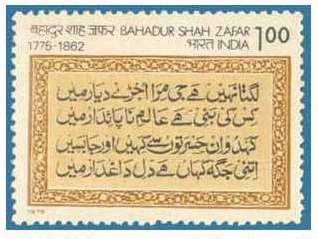FWP:
SETS == DOUBLE ACTIVATION; LIST
WINE: {49,1}
Hasrat takes a 'four-wave' [chār-mauj] to refer to a whirlpool [girdāb], and the use of the singular mauj rather than the plural maujeñ (along with the singular verb uṭhtī hai ) increases the plausibility of his suggestion. Hamid too makes this suggestion (p. 40), and it seems quite persuasive.
But there's more to be said on the subject of chār . It can often colloquially mean 'some, a few'. For example, Platts defines chār din as meaning ''Four days', a few days' (p.417).,
In the present verse the first reading would be 'a whirlpool', as Hasrat suggests. Or if not that, in view of the singular verb it would be something like 'a fourfold wave', some kind of special fancy wave. One or the other of these would be the best guess, after one had heard (under mushairah performance conditions) only the first line.
But then the second line would compel a mental re-imagining of chār mauj in the first line, since it would be clear that exactly 'four' different waves were in fact being enumerated. And perhaps we are also meant to think of the four traditional Greek-Islamic cosmological elements-- earth (rose), air (breeze), water (wine) and fire (sunset). Here, these elements seem to arise not from the forces of impersonal nature but from the microcosm of the lover's soul, from the 'storm of emotion/joy' in his heart.
In any case, both meanings remain fully relevant; this is a verse in which the expression chār mauj has been used with 'double activation' of its possibilities.
Ghalib always defeats you, though, when you try translating him. I remember how proud I was of coming up with my own version of this ghazal, and especially of this verse, which I knew was the best I could possibly do:
Out of the storm of joy
Four, flung from the vortex:
rose-wave, sunset-wave
wave of wind, wave of wine
And yet-- how unsatisfying. Even at the best, the sound effects you can get are so inferior to those of the original, the meaning is so attenuated or warped. What the hell is 'vortex' doing there? I can't seem to do without it, but obviously this is a 'transcreation'.
Some chār examples from Zafar--
NOT!
Reflecting on expressions with chār made me think of that famously melancholy verse that is generally attributed to Zafar:
paʾe fātiḥah koʾī āʾe kyūñ koʾī
chār phūl chaṛhāʾe kyūñ
koʾī ā ke shamʿa jalāʾe kyūñ mai vuh bekasī kā mazār hūñ
[why would anyone come to say funeral prayers, why would anyone offer
a few flowers
why would anyone come and light a candle-- I'm such a tomb of helplessness!]
The verse provides a fine example of chār meaning 'a few, some' rather than exactly 'four'. And thinking of that particular verse reminded me that this is as good a good place as any to share some information about it. Be sure you're sitting down before you read on.
For that whole famous ghazal, nah kisī kī āñkh kā nūr hūñ nah kisī ke dil kā qarār hūñ / jo kisī ke kām nah ā sake vuh maiñ ek musht-e ġhubār hūñ , doesn't appear anywhere in Zafar's four divans of poetry. The ghazal has been plausibly attributed to Muztar Khairabadi (1865-1927), with only minor changes in wording. The attribution appears in urdū ke ẓarb ul-maṡal ashʿār , by Shafiq Ali Khan (Karachi: United Book Corporation, 1988), p. 132; Shafiq Ali Khan cites both an essay by Yunus Hasni, shāh z̤afar nahīñ -- muẓt̤ar ḳhairābādī , that appeared in Nigar-e Pakistan, Jan. 1963, and also the testimony of Jan Nisar Akhtar and 'other trustworthy gentlemen'. (Muztar's divan has remained unpublished.) I'm grateful to Irfan Khan for pointing this out, and for providing the Urdulist with a very helpful discussion of the whole situation (Aug. 2005). For the latest on the subject, see 'Na Kisi Ki Aankh ka Noor Hoon was written by my grandfather' (quoting Javed Akhtar), by Sneha Mahadevan, Hindustan Times, Sept. 4, 2015. Also, here's the Yunus Hasni article itself.
It was a shock to me, and to the whole Urdulist, to have to make this mental adjustment. But I've gone carefully through the largest edition I have of all the four volumes in Zafar's complete works [kulliyāt], and sure enough that ghazal is simply not there. (Though it's clear that the various editions of Zafar's divan are surprisingly full of inconsistencies-- work definitely needs to be done on this!)
But we're not through yet. There's another ghazal attributed to Zafar-- and so famously so that it has acquired its own postage stamp: lagtā nahīñ hai jī mirā ujṛe diyār meñ / kis kī banī hai ʿālam-e nā-pāʾedār meñ :

This ghazal too, by coincidence, contains another chār verse that also illustrates the kind of 'double activation' effect that Ghalib created in the present verse:
ʿumr-e darāz māñg ke lāʾe the chār din
do ārzū meñ kaṭ gaʾe do intiz̤ār meñ
[having asked for a long life, we had brought four days
two passed in longing, two in waiting]
But more to the point, the closing-verse from that ghazal, as it's widely known, is:
kitnā hai bad-naṣīb z̤afar dafn ke liye
do gaz zamīn bhī nah milīñ kū-e yār meñ
[how unfortunate is Zafar! --for burial
he didn't even get two yards of ground in the beloved's street]
I wish I had a nickel for every time an Urdu-vala has recited that verse to me, and then has informed me with pride (because of its 'natural poetry' biographical realism) that in it Zafar was referring to his exile in Burma after 1857; he died in Rangoon as a British captive, and was buried there in an unmarked grave. Unfortunately for the 'natural poetry' fans, there's very little evidence that Zafar ever composed any more poetry after his four pre-1857 divans. These four he caused to be edited by Zauq, and then to be published by his own printing house, the Matba-e Sultani in Delhi; the final two divans of the set were published, with excellent timing, in 1856.
Then after that-- basically, nothing. There are various reports of Zafar's composing verses both during the Rebellion (some martial verses attributed to him apparently were in oral circulation at the time), and even after it, while in British captivity in the Red Fort (supposedly he scratched verses with a charcoal-tipped stick on the whitewashed wall of his prison chamber). He was in his eighties, and by all accounts was not always tuned in to the world around him. (Here is a photograph from that period.) If he did actually compose any verses under those circumstances, they haven't come down to us in any remotely reliable form. So even if Zafar had actually composed this verse during this period, it couldn't have been about his later exile in Rangoon. From his Rangoon period, we hardly even have any stories of verses attributed to him. We do however have this sketch, by Horatio Gordon Robley, a British officer posted in Burma at the time (with thanks to Mike Dottridge for providing it, in Jan. 2012).
So what is the source of that famous ghazal, if it's not in any reliable divan of Zafar's? One verse of it can be pinned down:
ʿumr-e darāz māñg ke lāʾī thī chār din
do ārzū meñ kaṭ gaʾe do intiz̤ār meñ
[Long-life, having asked, had brought back four days
two passed in longing,
two in waiting]
This one verse is found in the divan of Simab Akbarabadi (1880-1951), in an entirely different ghazal, with the difference that Simab wrote lāʾī thī in the first line, so that ʿumr-e darāz becomes the subject ( sīmāb akbarābādī , kalīm-e ʿajam (Karachi: Simab Academy Pakistan, 1985), p. 47; see also urdū ke ẓarb ul-maṡal ashʿār , p. 131). Another edition of Kalim-e ajam (Agra 1936) is available through rekhta.org, and here's page 372 with the ghazal in question (with thanks to Irfan Khan for his excellent research and analysis). As for the other verses, including the famous closing-verse, I'm still looking for a source.
To learn that these two famous and beloved ghazals are at least largely, and almost certainly wholly, misattributed is no doubt a bit of a shock. In Zafar's 'dargah' in Yangon (formerly Rangoon), the walls are nowadays adorned with exactly these two mis-attributed ghazals, as you can see: * nah kisī kī āñkh kā nūr hūñ *; * lagtā nahīñ hai jī mirā ujṛe diyār meñ * (photos courtesy of Asim Jaweed, Aug. 2019). Poor Zafar! To have composed such a lot of his own poetry, and then to be popularly famous for somebody else's!
Ask
yourself, though-- even if we have to rearrange our notions of their authorship,
don't we owe it to the real authors to do so? After all, Zafar has an immense
number of ghazals that he really did compose, and to which we have access;
his popularity also receives an extra boost because he's seen by many as a
kind of proto-nationalist quasi-mystical martyr figure. There's no reason
for us to deprive other poets of their own claim to fame. For a discussion
of verses similarly misattributed to Ghalib, see {219,1}.

Nazm:
He has given for the turbulence of emotion/joy the storm-producing sea, the waves of which he has mentioned in the second line. And in this simile too [as in 49,4}], the basis of similitude is movement. (45)
== Nazm page 45